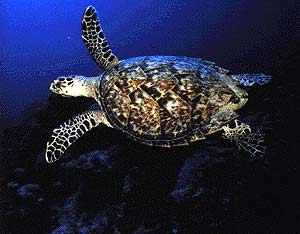by Anita Baskin-Salzberg & Allen Salzberg.
SEA TURTLES

Although sea turtles cannot withdraw their heads into their shells, the adults are protected from predators by their shells, large size, and thick scaly skin on their heads and necks.
Because sea turtles are difficult to study in the open ocean, scientists are just beginning to learn about the life history of sea turtles. Today, radio transmitters, attached to nesting turtles, help track the sea creatures on their travels and provide valuable information.

Although sea turtles move swiftly in the ocean, they are slow and defenseless on land. Male sea turtles almost never leave the water. Female sea turtles leave the ocean only to lay eggs and, for most species, nest only at night. A female may nest every two to three years.
Nesting can take between one and three hours. After a female turtle drags herself up the beach, she hollows out a pit with her back legs and deposits from fifty to two hundred eggs the size of golf balls. When the last egg is laid, the turtle covers the eggs with sand, tamps down the sand with her plastron, and flings more sand about with her flippers to erase any signs of the nest.
After about two months, the hatchling turtles emerge at night. The light reflected off the water from the sky guides them to the sea. These days, car headlights, street lamps, or lights on buildings near the beach cause some hatchlings to travel in the wrong direction. Waiting herons make fast meals of other hatchlings. Any babies still on the beach in the morning are easily picked off by predators or die in the hot sun. It is thought that when the surviving hatchlings reach maturity, they return to the beach where they hatched to lay their eggs.

AUSTRALIAN FLATBACK This medium-sized sea turtle nest on beaches in unpopulated areas of the northern coast of Australia. Saltwater crocodiles, as well as monitor lizards and foxes, sometimes eat small adult turtles while they are nesting.
GREEN This medium-to-large sea turtle (photo above right) gets its name from the green color of its body fat. Its smooth olive-brown carapace is heart shaped. Its serrated beak, notched like the edge of a saw, helps it feed on turtle grass and other marine plants. Green sea turtles in the eastern Pacific Ocean are called black sea turtles, although some scientists consider the black sea turtle a separate species.
HAWKSBILL This medium-sized sea turtle (photo near right) with a shield-shaped shell is found in tropical waters around the world. Names for its birdlike beak, the hawksbill usually nests near its feeding grounds and mates in shallow water off the nesting beach. Hawksbills climb over reefs and rocks to nest among the roots of vegetation on beaches.
KEMP’S RIDLEY Also called the Atlantic ridley, the Kemp’s ridley is the world’s most endangered sea turtle. Very little is known of its habits. It is known that between April and mid-August, the turtles nest in large groups called arribadas, Spanish for “arrival,” in only one place in the world: a beach near Rancho Nuevo, Mexico. In 1947, over forty thousand female Kemp’s ridley turtles nested on that beach in a single day; in 1992, only five hundred came to nest.
LEATHERBACK The largest of all sea turtles, the leatherback can grow to over 7 feet (2 m) long. These tireless swimmers have been found throughout the world’s oceans, as far north as Newfoundland and as far south as the southern coast of Chile. Leatherbacks can also dive to great depths, as far as 3,000 feet (914 m) deep, probably in search of their favorite food — jellyfish.
LOGGERHEAD Known for its massive reddish brown head, the large omnivorous loggerhead sea turtle eats fish, jellyfish, mussels, clams, squid, shrimp, seaweed, and marine grasses. The loggerhead travels widely and has been found as far as 500 miles (805 km) offshore. In many areas of the world, this turtle is hunted for its meat and eggs.
OLIVE RIDLEY Also called the Pacific ridley, this small sea turtle has paddlelike flippers and grows up to 28 inches (71 cm) long. A speedy nester, it spends only about forty-five minutes on the beach laying its eggs. Like the Kemp’s ridley, it nests in arribadas.
Return to Turtles page.